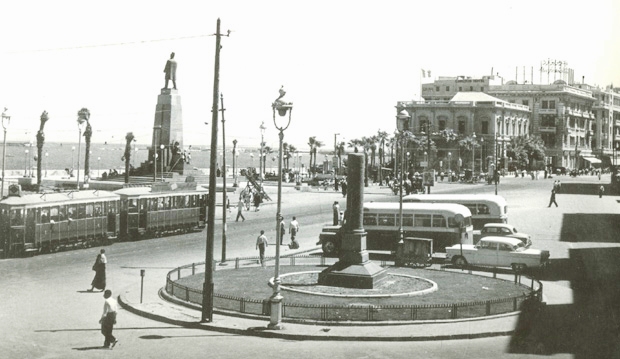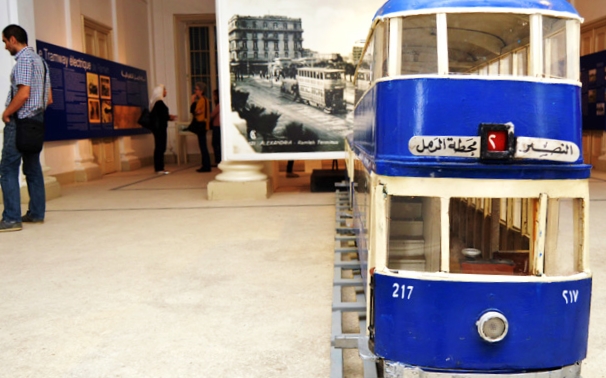An ambitious new modernization project supervised by the French Development Agency (FDA) and the European Union (EU) is set to restore the Alexandria Tram to its former glory.
by Farah el-Akkad
photos by Mohsen Allam
Nothing compares to a leisurely stroll down the old, historic streets of Raml district in Alexandria. One of the main landmarks of Mahatet El Raml (Ramleh Station) is the historic tram which transported its first passengers in 1860. Alexandria’s tram is mostly blue with a number of smaller yellow vehicles. At LE 1 it is one of the city’s cheapest means of public transportation and was, until the 1990s, a popular tourist attraction. Built in 1860, the compartments of the early trams were horse drawn until 1863 when steam was introduced. Tram Alexandria - or Tram Ramleh - is considered the first tram system in Africa and one of the oldest in the world.
 Raml Station in the 1920s.[/caption]
Raml Station in the 1920s.[/caption]
 To commemorate the tram’s anniversary, an exhibit of rare black-and-white photos chronicling the tram’s history was organized by the FDA in collaboration with the French Cultural Institute in Alexandria and the ministries of Transport and International Cooperation.[/caption]
To commemorate the tram’s anniversary, an exhibit of rare black-and-white photos chronicling the tram’s history was organized by the FDA in collaboration with the French Cultural Institute in Alexandria and the ministries of Transport and International Cooperation.[/caption]
The FDA has pledged a EUR 500,000 grant from the EU for the rehabilitation of the El-Raml Tramway as a short-term priority transport project for Alexandria.
"Urban transportation in the city center and the east is dominated by taxis (33 percent), buses (25 percent) and private cars (15 percent). Although Alexandria has had a tramway since 1860 (the oldest in Africa), it is only used by 12 percent of daily commuters,” the FDA says.
The tram service has become so ineffective that many commuters have stopped using it. “The low quality of service, particularly due to numerous intersections with traffic, is the reason for the 57 percent decrease in passengers over 12 years,” the FDA says.
I decided to ride the tram and see for myself. The tram’s main stop at Raml station is located across Al Qaed Ibrahim Mosque, a five-minute walk from the landmark Patisserie Delices founded by Greek businessman Kleovoulos Moustacas at the beginning of the 20th century.
I board the blue tram Number 2 which starts here at Raml station on the west side of the city and travels to Victoria on the east side, a little over halfway to Montazah. I pay LE 1 for a regular tram (LE 5 will get you aboard the special Tram-Café, opened by former Governor Hany El Messiry in 2015 including free Internet and comfy sofas). I have a few minutes before the train sets off, so I walk up to the driver’s carriage for a chat. “My father was also a tram driver during the 50s, before that most tram drivers were Italian,” says Ezzat Ali, the 58-year-old driver who has been operating the tram since he was in his 20s. Ali remembers when his own father used to ride the tram back in the 1940s: “I remember he used to describe its dark red curtains and cozy sofas. It also included a black colored vehicle for funerary purposes.”
As the train chugs off, I take a seat next to Sophie, a 41-year-old Swedish architect who takes the tram daily from her home in San Stefano to work in Raml. “It is easy to take the tram if you are familiar with the stations,” she tells me. “It is a bit slower than a taxi, but it suits me.”
Tram Ramleh stops at most of Alexandria’s prominent districts such as Loran, Zizinia, Gianaklis, Blockley and San Stefano, most of which are named after prominent foreign residents who once called the city home. Zizinia, for example, is the name of an Italian count who a famous cotton merchant during the 19th century.
I strike up a conversation with another, elderly passenger. “We have so many treasures and so many stories to tell. Egypt is a very rich country, if any other country has half of our history, it would be one of the richest in the world but sadly Egyptians do not know their land’s real worth,” 70-year-old Afaaf Gamal tells me.
Toasting the Golden Days
The project to rehabilitate the El-Raml Tramway is set to start right away and is testament to the FDA's "continuous efforts in the sector of public transportation in Egypt," said Maha Nabil, the agency's Senior Communication and Administrative Manager.
The overhaul aims to make the tramway smoother by removing unnecessary existing branches and changing the location of certain stations (27 stations spaced on average 500 meters apart), Nabil says. The new tram will provide faster service by minimizing the intersections between the tramway and road traffic through viaducts and underpasses. Stations will be upgraded by installing shelters, seating, ticket dispensers and signposts. Economically, the project is expected to improve productivity through the minimization of travel times between the two terminals of Raml Tramway, slashing ride durations from the current 60 minutes to 30 minutes.
There is a humanitarian aspect to the overhaul, since most of the passengers come from disadvantaged backgrounds, one goal is to raise the level of comfort for tram users. By tripling the capacity of El Raml Tram from current 4,700 passengers to 13,800 per hour/direction, the FDA and the Railway Authority aim to encourage more Alexandrians to use public transport instead of cars and taxis, thereby unclogging traffic.
“We do not see this project as just a bunch of signed papers,” says Nabil. “We truly hope that it helps bring to life the world of a vanished Alexandria as Michael Haag states in his book Vintage Alexandria: ‘the vibrant, stylish and cosmopolitan city that was once a prosperous gateway between Egypt and the world.’”
Comments
Leave a Comment